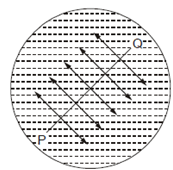Surface and Interior of a Liquid:
When small insects move on a liquid surface or when we place a sewing needle on a liquid surface, a surface of water is slightly depressed under the feet of the insect or under the needle. At these points, the cohesive force among the surface molecules gives rise to a restoring force which is equal in magnitude and opposite in direction of the weight of the insect or the needle. As a result, cohesive force tends to restore the horizontal surface of the liquid. It is, however, important to mention here that when the weight of the insect or the needle become very large, the restoring force due to cohesion can no longer support them and they sink in the liquid.

Figure: Cohesive Force between Molecules on the Two Sides of a Line, PQ, on a Liquid Surface
To obtain an analytical expression for the surface tension, let us consider an imaginary line PQ drawn on the free surface of a liquid (Figure). Due to cohesive force, the molecules just lying on one side of the line PQ try to pull away from the molecules lying just on the other side so as to decrease the surface area. Surface tension is essentially a manifestation of the cohesive force among the surface molecules of the liquid. Therefore, it is measured as the force per unit length acting perpendicularly on either side of any imaginary line in the liquid surface in equilibrium; the direction of the force being tangential to the surface. Mathematically, we write
Surface Tension (σ) =Force/Length = F/l . . . (1.1)
where F is the force acting on either side of the line PQ which is of length l. The unit of surface tension in SI system is Newton per metre (Nm- 1) and its dimensions are MT - 2.
It is important to mention here that the value of surface tension depends on the temperature of the liquid: the value diminishes with the rise in temperature. At 20oC, the values of surface tensions of water and mercury are given below:
(σ)water = 72.6 × 10- 3 N m -1
(σ)mercury = 465 × 10- 3N m-1
Here let us now discuss some more day-to-day observations which can be explained on the basis of surface tension.